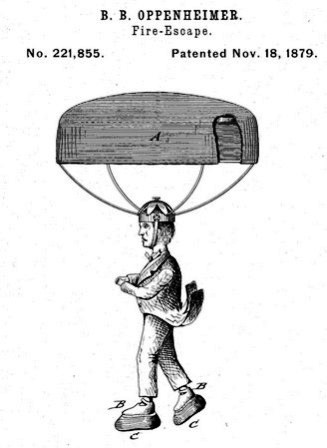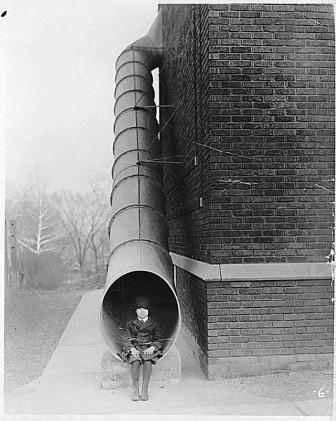Fire Escapes
Fire Escapes of the 1800s
FIRE! FIRE! A person’s first thought: Escape!
Hotels of the 1800s were constructed of the most common material available: wood. Buildings in towns were often connected by a common wall; e.g., a hotel might be connected by a common wall to a saloon, which might be connected to a general store. New household technologies such as oil and gas lamps, kitchen ranges, and small bathroom boilers called ‘geysers’ were becoming commonplace causes of fires. A fire in one building might easily result in a catastrophe with lives lost.
How did a hotel patron escape a fire safely? National Archives archivist Julie Halls, authored a section about fire escape patents in her book Inventions That Didn't Change the World. She said, ”There’s a flimsy looking contraption designed to catch you if you jump out of a window, and various baskets attached to ropes and pulleys that are meant to lower to the ground. Although none of them look very practical, they do reflect the fear of fire at that time.” That ‘contraption’ was patented by inventor W.W. Van Loan on January 7, 1890.
Patents for safe extrications from buildings increased from just a handful before 1860 to dozens each year in the 1860s. The demand, coming from middle-class consumers, inspired the invention of a range of mainly impractical things called ‘fire escapes’. Imagine wearing B.B. Oppenheimer’s  1879 fire escape helmet as you jumped from a burning building, or quickly donning Pasquale Nigro’s proposed 1909 patent for a fabric-covered set of wings, allowing its wearer to fly down to safety!
1879 fire escape helmet as you jumped from a burning building, or quickly donning Pasquale Nigro’s proposed 1909 patent for a fabric-covered set of wings, allowing its wearer to fly down to safety!
Local authorities in many states adopted a rope fire-escape law for hotels, which had the second highest fatality rate after theater fires. Ropes were placed in guestrooms, assuming frightened guests would climb down ropes from windows high above street level. Eventually, in the early 1900s, architects incorporated fire  towers, exterior stairs built with the similar strength of interior stairs, and other alternative exit routes.
towers, exterior stairs built with the similar strength of interior stairs, and other alternative exit routes.
FIRE! FIRE! … still strikes fear into a person’s heart. Luckily, chances for survival have dramatically improved since the days of fire escape helmets, ropes, and pulleys.
Photos: Oppenheimer’s ‘Fire Escape’, 1924 Fire Escape Chute
This article was written by Susan Brushafer, an RHS volunteer. Join the Richfield Historical Society if you enjoy fully researched articles. Three times per year, members receive a Newsletter filled with articles and Society news. To join, click here.
Enjoy our other stories

